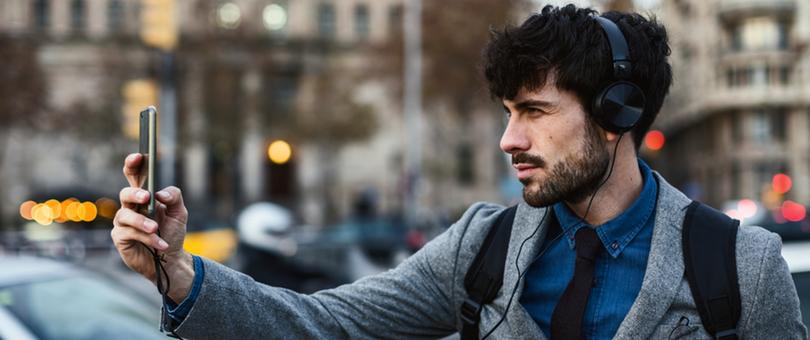If you’re not familiar with augmented reality (or AR), you’ve at least seen it in action by now.
That’s because unlike its cousin virtual reality (VR)—which requires a headset to remove us from this world and immerse us in another—AR uses your smartphone camera to turn the real world around you into a canvas that can be enriched with interactive virtual objects.
AR works by using computer vision and tracking through your camera to anchor a virtual object to a physical point in your environment. As you move your camera around it, or closer and further away, the object is able to maintain its scale and location in your view of the real world.
But even with all the potential you can imagine for technology like this, the quality of the experiences so far meant it was still fairly easy to write off AR as a gimmick rather than a game-changer in the world of commerce.
Until now that is.
Augmented Reality: not-so-new but vastly improved
The term “augmented reality” was first coined and applied practically in the early 90s. It was developed by the U.S. Air Force's Armstrong Labs and involved a complicated setup that looked like this.
Since then, there have been several attempts—like the Google Glass—at creating a lightweight headset that lets you view augmented reality on the go. But these were never really made with the masses in mind—the technology and the market just weren’t ready for wearable AR.
But that wasn’t the case for mobile AR. Snapchat’s Lenses and the popular location-based game Pokemon Go familiarized users with the idea of interacting with virtual objects through their smartphone camera in what were the first significant examples of consumers embracing AR.
The technology was far from perfect, though. The objects wouldn’t always stay in place if you moved your camera, nor would they realistically scale in size based on your distance from them.
As a result, you could still easily distinguish between real and augmented reality.
That changed, however, when Apple announced iOS 11 and ARKit—giving developers the tools to create better, more realistic AR experiences—where the virtual objects that “augment” the reality are almost indistinguishable from the reality they’re dropped in.
And with it, augmented reality’s potential has moved beyond the games and mildly amusing tricks of its past, towards more immersive, more practical experiences for consumers and brands alike.

Free Reading List: Ecommerce Motivation
Having trouble focusing on growing your small business? Get access to our free, curated list of high-impact productivity articles.
Get our Ecommerce Motivation reading list delivered right to your inbox.
Almost there: please enter your email below to gain instant access.
We'll also send you updates on new educational guides and success stories from the Shopify newsletter. We hate SPAM and promise to keep your email address safe.
Bringing products to virtual life in front of you
Perhaps the biggest commercial opportunity within these improved AR experiences is how they give us a better sense of scale and let us closely evaluate products as if they were right in front of us.
“Will this couch fit in the corner of my living room?”
“How will this vase look on my table?”
Instead of wondering about these things, consumers can project a virtual version of the product into their own homes through their smartphone camera.
For Magnolia Market, a home and lifestyle business in Waco, Texas, owned by Chip and Joanna Gaines of HGTV’s Fixer Upper, AR was the perfect way to let shoppers see what Magnolia’s products would look like in their own homes through the Magnolia Market app.
The AR team at Shopify worked with Magnolia to integrate ARKit into their native app. 3D models of select products were created in-house to capture as much detail and realism as possible to let shoppers see a product from the front, back, top, inside—whatever angle they wanted.
This was the result:
According to Stone Crandall, Digital Experience Manager at Magnolia, “When people come to see us in Waco, we want to make sure every detail captures the true spirit of Magnolia. Not everyone is able to visit us in person, but it was still important to us that the finer details of the in-store experience come through for those shopping online and on-the-go—augmented reality makes that possible.”
“With this technology, users can see our products up-close to examine the intricacies that make them special and unique,” Stone says. “We always want our guests to leave feeling inspired by what they’ve experienced, and thanks to the new Magnolia app, they’ll be able to do just that—no matter where they’re located—from the palm of their hands.”

The option to virtually place products in your own home ultimately leads to a more informed buying experience, explains Stone.
“Thanks to AR, online shoppers will now have the answers to: How will this piece look in my home? How big is the item in real life? What does the inside look like, or the back? At the end of the day, nothing tops the in-store experience, but AR provides the capabilities for guests to make equally informed buying decisions from afar, at all hours of the day.”
Your smartphone camera: an augmented mirror
For other businesses, the advantages of AR don’t just lie in augmenting your surrounding environment but in your own appearance as well.
Flipping your smartphone’s rear camera to your front-facing one, AR promises a “mirror” that lets you answer the question, “I wonder what this would look like on me?”
Since facial features are generally consistent across people (the placement of the eyes, nose, mouth etc.), fun applications of this technology on Instagram, Facebook, and Snapchat have already become popular through social media.
But beyond sporting virtual puppy dog features, some businesses are seeking out practical ways to use facial tracking to augment your selfies.
Eyewear and cosmetics immediately come to mind—two types of products that you'd want to try before you buy.
That's why, earlier this year, Sephora updated its app with a "virtual try-on" feature that lets you sample their make-up against your specific complexion. Eyewear companies like Glasses.com have also experimented with a similar feature in the past to virtually try on different styles of glasses.

Every face is different and the option to test out a few different looks in the comfort of your home could revolutionize the way people shop for these products.
Improvements in AR can only make these experiences better, more useful, and more common over time.
Building virtual worlds on top of our own
It sounds crazy when you think about it, but as you walk through the streets, there could be a multitude of virtual worlds layered upon our own.
Whether it's searching for fictitious creatures roaming about or large-scale battles to be fought and won, location-based AR forces us to physically be in a certain place that corresponds with that point in the virtual world.
This type of AR was actually one of the first to reach smartphones via a browser app launched by Wikitude in 2008. This app let you view information about real world places around you by pointing your camera at them.
Now, we're seeing other interesting applications of location-based AR, from Snapchat's AR art installations designed by American artist Jeff Koons, to this clever concept by Neon for a social AR app that helps you find your friends in a crowd.
🤳 1. Hold up your iPhone → 2. Find your festival friends → 3. Rock on 🤟 Courtesy of ARKit 💖 Demo = @neonapp by @mrdavidurbina 🦄 pic.twitter.com/S9mp5Mjlal
— ARKit Weekly (@ARKitweekly) August 15, 2017
Building upon our current world with virtual layers is one thing. But the fact that countless virtual versions of the world can exist simultaneously—that you and I can walk into the same room and see completely different things—is what's truly exciting.
This is only the beginning for augmented reality
AR's full potential has often been out of reach of the technology of the present. But that's on the verge of changing.
Apple's ARKit (and now Google's ARCore) have given builders the world over the tools they need to make bigger and better bets with AR, to blend the virtual and the real more seamlessly than ever before.
And while smartphones have brought us AR experiences that fit comfortably in our palms, how much longer will it be until we start seeing everyday wearable glasses that let us experience AR hands-free?
There's still a lot to figure out, but as with all game-changing technology that was once young and untapped, it's only a matter of time until the world of tomorrow becomes today's.
Shopify AR provides an accessible toolkit for businesses to create their own AR experiences for their stores.


